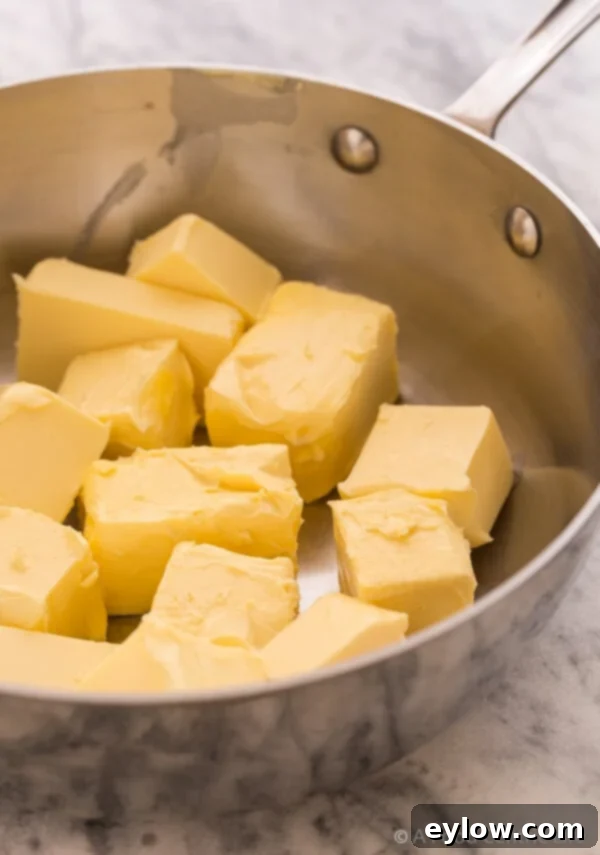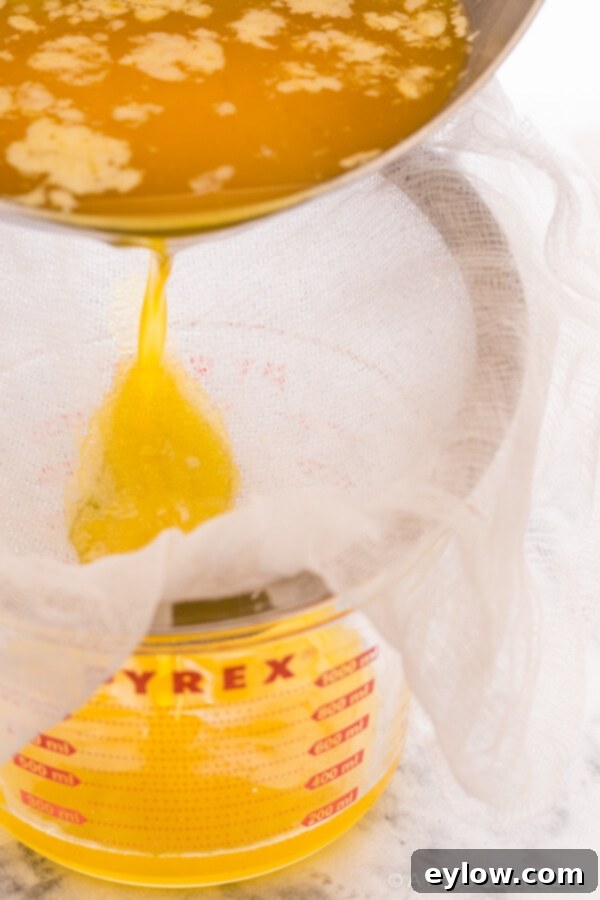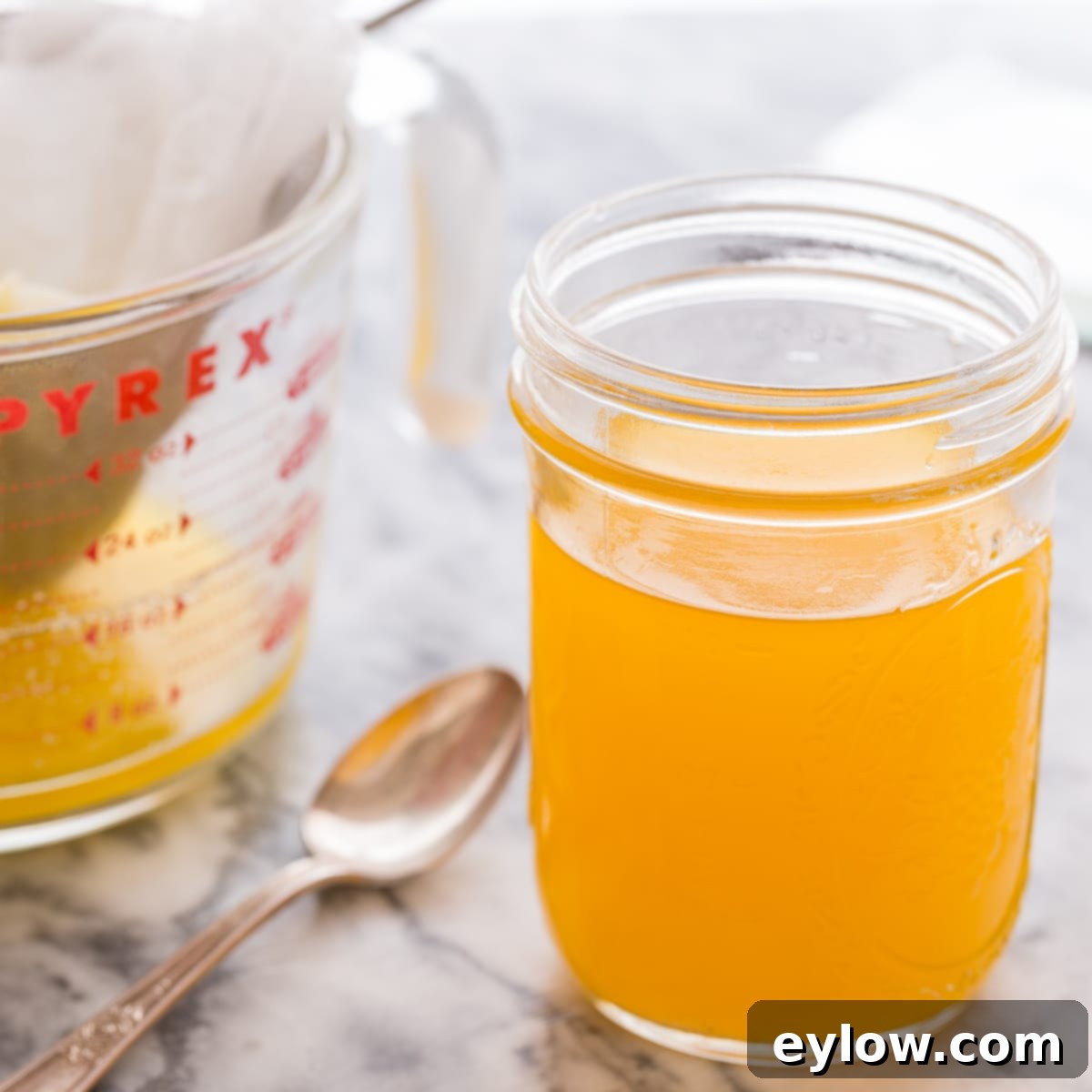How to Make Clarified Butter (Ghee): Your Ultimate Guide to Dairy-Free, High-Heat Cooking & Health Benefits
Discover the simple art of making clarified butter, often known as ghee, right in your own kitchen. This pure cooking fat is a golden elixir that many individuals with dairy sensitivities find perfectly compatible with their diet, as the clarifying process meticulously removes milk solids and water. The remarkable benefit? You retain that rich, unmistakable buttery flavor without the common irritants found in traditional butter. While gourmet stores often stock clarified butter, mastering its preparation at home is an easy, quick, and rewarding endeavor, giving you superior control over its quality and freshness.

While many modern kitchens lean heavily on oils like olive oil for daily cooking, there are undeniably those culinary moments when only the profound, comforting taste of butter will suffice. Whether it’s to create exquisitely soft scrambled eggs, sauté delicate mushrooms to perfection, whip up a silky hollandaise sauce, or achieve that perfect pan-sear on a succulent steak, butter adds a dimension of flavor that is truly unparalleled. But what if dietary restrictions, like a dairy intolerance or sensitivity, prevent you from enjoying this beloved ingredient? This is where clarified butter steps in as a game-changer, offering all the flavor without the typical dairy components.
What is Clarified Butter (Ghee)? Understanding This Golden Elixir
To truly appreciate clarified butter, it helps to understand what regular butter actually is. A standard stick of butter might appear to be solid fat, but its composition is typically around 80% fat, 15% water, and 5% milk solids. The magic of clarification lies in a gentle cooking and straining process that carefully separates and removes these milk solids and water. What remains is a pure, golden fat, highly stable and excellent for a wide range of cooking applications. It’s these very milk solids—specifically proteins like casein and whey—that often trigger digestive issues or allergic reactions in dairy-sensitive individuals.
Clarified butter is also widely recognized by its ancient Indian name, ghee (pronounced “gee”). While the terms “clarified butter” and “ghee” are frequently used interchangeably, there’s a subtle distinction in their preparation. When making ghee, the milk solids are typically cooked slightly longer, allowing them to caramelize and impart a richer, more toasted, and distinctly nutty flavor profile. This longer cooking time is characteristic of traditional Indian cooking, where ghee has been a cornerstone ingredient for millennia, not just for its flavor but also for its revered health properties. Some traditional Indian ghee recipes even incorporate spices like turmeric during the clarification process, adding further layers of aroma and beneficial compounds.

Unlock the Health Benefits of Clarified Butter
Concerns about the saturated fat content in butter have long been a topic of debate. However, contemporary nutritional science suggests a more nuanced understanding: there’s increasingly little evidence to definitively prove a direct link between dietary saturated fat and heart disease in healthy individuals. For those interested in exploring the latest research and perspectives on healthy fats, a valuable resource is Dr. Mark Hyman’s book, “Eat Fat Get Thin.” Specifically, Chapter 8 offers an insightful explanation of clarified butter’s role within a healthy diet, dispelling common myths and highlighting its advantages.
When incorporated into a balanced lifestyle—one that emphasizes whole foods, is low in refined carbohydrates and sugars, and rich in fiber—clarified butter can indeed be a remarkably healthy fat. Beyond its culinary appeal, ghee has been traditionally celebrated in Ayurvedic medicine for a multitude of potential health benefits. It is thought to significantly improve digestion by stimulating digestive enzymes and soothing the gastrointestinal tract, thus promoting overall intestinal health. Its anti-inflammatory properties are believed to help decrease inflammation throughout the body. Furthermore, ghee is rich in fat-soluble vitamins (A, D, E, K2), which are crucial for building strong bones, supporting immune function, and maintaining proper hormone balance. Some evidence even suggests its role in promoting satiety and supporting healthy weight management. And, of course, a significant health benefit that can’t be overlooked is its simply fantastic taste, making healthy eating more enjoyable!

Why Clarify Butter? The Key Advantages for Your Kitchen and Health
There are two primary, compelling reasons to clarify butter, both impacting your cooking performance and dietary wellness.
First, clarified butter boasts a significantly higher smoke point compared to regular butter. The smoke point is the temperature at which a fat begins to break down, literally smoking and producing harmful free radicals, thereby becoming unhealthy to consume. While regular butter has a smoke point of about 350°F (177°C) and extra virgin olive oil around 320°F (160°C), clarified butter shines with an impressive smoke point of approximately 450°F (232°C). This makes it ideal for high-temperature cooking methods like searing, frying, and roasting, where regular butter would quickly burn and impart a bitter taste. For comparison, avocado oil reaches an even higher 520°F (271°C), and unrefined coconut oil is similar to butter at 350°F (177°C). The elevated smoke point of clarified butter means you can achieve that beautiful caramelization and crispiness without compromising the integrity or healthfulness of your food.
Second, clarifying butter effectively removes the milk solids, leaving behind a pure fat. This is a crucial benefit for many individuals. People who are lactose intolerant or those with sensitivities to dairy proteins like casein and whey often find that they can comfortably enjoy clarified butter. Since the offending milk proteins and sugars (lactose) have been carefully cooked out and strained away, clarified butter becomes a delicious and versatile dairy-free alternative, allowing them to enjoy the rich taste of butter without the associated discomfort. This makes it a staple for diets such as Whole30, Paleo, and the Autoimmune Protocol (AIP).

Understanding Butter Quality and Saturated Fat
The foundation of excellent clarified butter begins with selecting high-quality regular butter. Always opt for unsalted, organic, or even better, pastured butter. Organic and pastured butter ensures that you are starting with a product free from undesirable additives such as growth hormones, antibiotics, harmful pesticides, and GMOs. More importantly, these premium butters boast a significantly more healthful fat profile, which directly contributes to the nutritional value of your clarified butter.
The nutritional quality of butter is intrinsically linked to the diet of the cows that produce the milk. While all butter is approximately 50% saturated fat, the overall fatty acid composition and micronutrient content vary dramatically. Butter derived from grass-fed (pastured) cows is superior. These cows graze on their natural diet of fresh grass, which leads to butter rich in beneficial compounds. Specifically, pastured butter has an ideal omega-6 to omega-3 fatty acid ratio, often closer to 1:1, which is considered optimal for human health. In contrast, butter from grain-fed cows, typically raised in Concentrated Animal Feeding Operations (CAFOs) or factory farms, tends to have a much higher and less favorable omega-6 ratio. Most modern Western diets already contain an excess of omega-6 fats, so choosing pastured butter helps balance this ratio. Beyond fatty acids, grass-fed butter is also higher in conjugated linoleic acid (CLA), a potent fatty acid linked to various health benefits, and fat-soluble vitamins like A, D, E, and especially K2, which plays a critical role in bone and cardiovascular health. Furthermore, butter from conventionally grain-fed cows can accumulate pesticide residues and environmental toxins, substances you certainly don’t want in your pure clarified butter. Investing in high-quality butter is an investment in your health.

How to Make Clarified Butter: A Step-by-Step Guide
Making clarified butter is a surprisingly simple process that transforms regular butter into a versatile, pure fat. Here’s how to do it effectively:
Start by placing your unsalted butter (preferably organic and pastured) into a small, heavy-bottomed saucepan. Begin melting the butter over very low heat. This initial gentle melting phase is crucial to prevent burning. Once the butter has completely melted, slightly increase the heat to a low-medium setting, allowing it to gently simmer. This simmering process cooks off the water content and encourages the separation of the milk solids from the pure butterfat. This stage typically takes about 8-10 minutes, but the duration can vary based on the amount of butter and the heat level.
During the simmering, you’ll observe distinct changes. Initially, you’ll see larger bubbles forming on the surface as the water begins to evaporate. As more water cooks off, these bubbles will become smaller and less frequent, and the gentle bubbling sound will noticeably quiet down. Concurrently, a creamy white foam will develop on top—these are the milk solids rising to the surface. It’s these milk solids that are responsible for butter burning at high temperatures, so their removal is key. Beneath this foam, you’ll begin to see a beautiful, clear, golden liquid—this is your clarified butterfat. You might also notice a subtle, delightful change in aroma; it will develop a slightly nutty fragrance, reminiscent of browned butter, indicating the milk solids are caramelizing slightly, especially if you’re aiming for traditional ghee.
Once the bubbling subsides and the foam is pronounced, it’s time to strain. Carefully remove the pan from the heat. Line a fine-mesh sieve with four layers of cheesecloth (or a coffee filter for ultra-fine straining) and place it over a clean, heat-proof glass jar or container. Slowly and carefully pour the melted butter through the prepared sieve, allowing the pure, clear golden butterfat to collect in the jar. Be gentle as you pour, leaving behind any solid particles that have settled at the bottom of the pan. You should be left with a pristine, translucent golden liquid. Expect to lose approximately 20%-25% of the original butter’s weight due to the removal of water and milk solids. While some sources suggest clarified butter doesn’t strictly require refrigeration, it is best practice for extended freshness. Store it in the refrigerator, where it can last for an impressive 3 to 6 months. For an even longer shelf life, some opt to freeze it.
📖 Recipe

How to Make Clarified Butter (Ghee)
Sally Cameron
Pin Recipe
Equipment
-
Cheesecloth
-
Fine sieve
-
Small, heavy-bottomed saucepan
-
Heat-proof glass jar or container
Ingredients
- 8 ounces unsalted pastured organic butter
Instructions
-
Place the unsalted butter in a small, heavy-bottomed 2-quart pan over very low heat. Allow the butter to melt slowly and completely. Once fully melted, increase the heat slightly to a low-medium setting and let the butter gently simmer. This process will cook off the water and separate the milk solids. This typically takes another 8-10 minutes. Observe the bubbles: they will initially be large, then gradually become smaller as the water evaporates, and the bubbling sound will quiet down.
-
When the bubbles are very small, most of the water has evaporated, and a distinct whitish foam (the milk solids) has formed on top, remove the pan from the heat. Carefully pour the clarified butter through a fine sieve that has been lined with four layers of cheesecloth into a clean, heat-proof glass jar or container. Ensure you leave any remaining solids at the bottom of the pan behind. You should be left with pure, clear, golden butterfat.
-
Once cooled, seal the jar and refrigerate the clarified butter. It will solidify and can be stored for 3-6 months. Use it as desired for all your cooking needs, especially for high-heat applications or as a dairy-free alternative.
